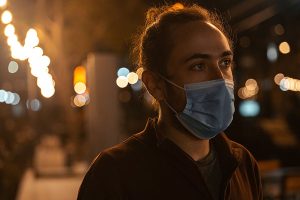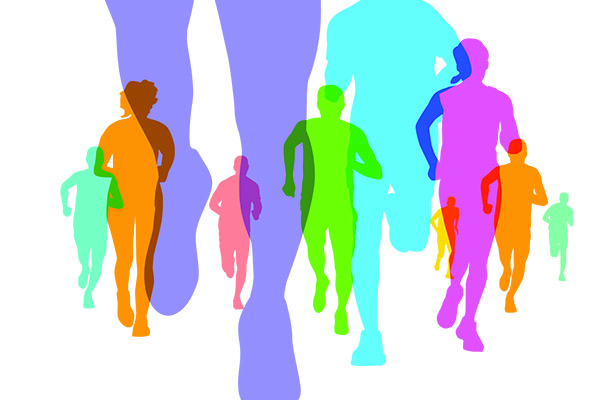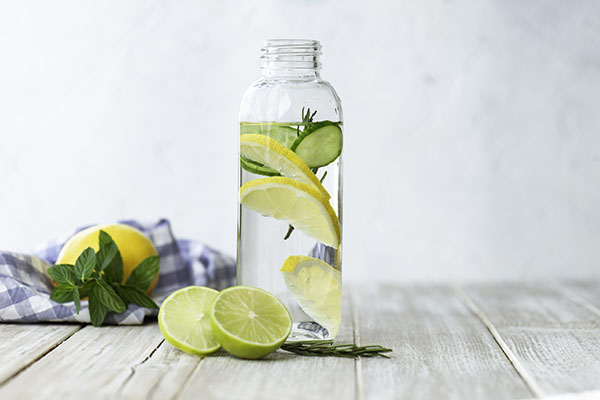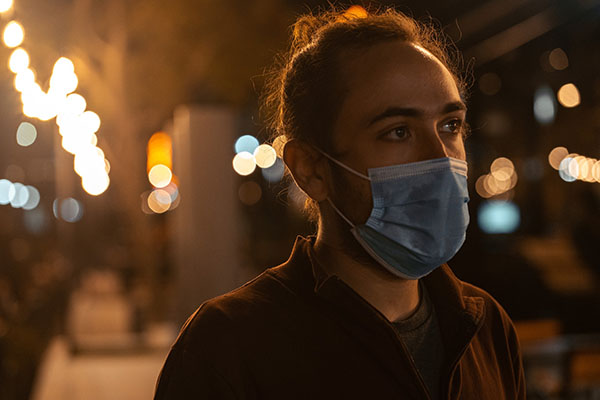Salmon Croquettes with Dill Sauce

Feta-Sweet Potato Salad

Time to Start Running?
Staying in shape this past year has not been easy. First COVID-19 hit. Gyms closed and we were sequestered at home. Then came the wet, cold, dark of winter. Now, with spring in full bloom, it may be time to get moving. Dr. Gregory Grant shares this advice on how to choose the right running shoes.
Running is a great form of exercise because it’s so easy. Almost anyone can do it. You don’t need a gym membership or elaborate equipment, just a good pair of running shoes.
That said, not any pair of athletic shoes will do. You should invest in high-quality shoes designed specifically for running. Most good running shoes cost upward of $100, which may sound expensive, but the support they provide to your feet will be well worth the investment.
If you’re just starting out, I suggest going to a shoe store with a knowledgeable staff. They may ask a number of questions: do you have a high or low arch, what type of surface will you typically be running on, and do you have a neutral gate or tend to over-pronate or over-supinate.
One good way to determine your arch is to stand on some sand. The more foot you see in the footprint, the flatter your foot tends to be. It’s not that having a high or low arch is a good or bad thing. Many people have a good arch but still have a weak foot, and they complain of the same foot- and lower-back-pain issues that someone with a flat foot does.
A weak foot does not provide any padding when the foot strikes the ground. When the heel hits, there’s no cushioning. Think of it like shocks on a car. If someone has a low arch or weak foot problem, they don’t have a shock absorber, and they tend to have lower back pain. Someone with a strong foot will not have those issues. On the other hand, if your foot tends to be really rigid, like someone with a really high arch, the shock absorbers will be too ratcheted up, so that’s not good for long distances.
Over-pronating or over-supinating
With a neutral or ideal gate, your heel strikes, then your foot comes down in a stable platform, and you push off ever so slightly from your big toe. With over-pronators, the foot rolls excessively on impact, which puts pressure on the inside of the foot. Over-pronators are susceptible to shin, arch and heel pain. Over-supinating means that when your foot hits the surface, weight transfers to the outside of your foot, causing you to push off from the toes and lateral side of the foot. Without correct shoes, over-supinators are prone to plantar fasciitis, shin pain or ankle sprains.
Starting on the right foot
I recommend that runners choose a softer surface to run on, at least in the beginning. A high school track is a great option because it’s flat and has more cushioning than hard asphalt or concrete. Trail running can also provide a softer surface. With an uneven trail surface, however, you need to train the involved muscles so you don’t end up with a sprained ankle or foot.
Overtraining is another factor that can lead to foot problems. Many people, especially beginners, tend to run too far, too fast. I encourage runners to start off slow: maybe run a half mile, or alternate running and walking. You should also take a minimum of one day’s rest between running days. On the off days you can cross train—lift weights, swim, row or ride a bike.
One more point, those running shoes—even if they are a great pair of high-quality stabilizing shoes—need to be replaced after about 400-500 miles. And that doesn’t mean relegating them to become your gardening shoes. Gardening can also be a stressful activity on your feet. If that shoe is worn out for running, it’s also worn out for gardening.
The best advice I can give to anyone experiencing foot pain is to come in early. The great thing about PacMed is we are all connected. I share notes with the primary care providers, and they share notes with me. Basically, we are all working from the same sheet of music—which benefits runners of any caliber.
Gregory Grant, DPM, FACFAS, is a podiatry specialist at our Canyon Park clinic. Call 1.888.472.2633 for an appointment.
A Tale of Two Sisters: How colonoscopies save lives
 When Barbara Bailey had her first colonoscopy, PacMed doctors found and removed a number of precancerous polyps. Then her sister, just a year older, died of colon cancer.
When Barbara Bailey had her first colonoscopy, PacMed doctors found and removed a number of precancerous polyps. Then her sister, just a year older, died of colon cancer.
“It was not nice to look at my sister in that condition—it was terrible,” says Barbara. “She had got to the point where she was too far gone, and she couldn’t even get chemotherapy. If I can prevent that for myself—even if I was to come down with colon cancer, perhaps they can catch it at the beginning, and maybe something can be done.”
“I always make sure that I told my children that, when they get a certain age, that they need to make sure they have colonoscopy testing,” Barbara adds.
According to Dr. John Brooling at PacMed, “African Americans should begin screening at age 45 due to higher mortality and incidence. If you have a family history, you should talk to your doctor to determine the right age for you.” As a general rule, a person without a family history of colon cancer should begin screening at age 45, according to recently updated guidelines.
Since her polyps form quickly, Barbara has yearly colonoscopies, at the recommendation of her physician, Dr. Rex Cheng, who works with Dr. Brooling as part of PacMed’s Gastroenterology team.
“It made me feel like it was really important to me to continue having colonoscopies done,” says Barbara, “because [colon cancer] could possibly happen to me, and if so, I want to be ahead of it, before it got to Stage IV or something. It made me look at what I really need to do.”
As Dr. Brooling explains, a colonoscopy is the best available screening test to detect colorectal cancer. “During a colonoscopy, the doctor examines the lining of your entire colon to check for polyps or tumors. The procedure itself usually goes pretty smoothly. We do put people to sleep, which involves a degree of risk, but we closely monitor the patient throughout the entire procedure. Also, our anesthesia team at PacMed now uses propofol, so the sedation puts people to sleep deeper, but they wake up quicker and are not as groggy.”
The “prep” process that cleans out the colon and rectum prior to a colonoscopy may deter some people from getting this important screening. However, newer kits are available that may make the prep more tolerable. “If you don’t want to do a colonoscopy, there are other options such as annual stool tests,” says Dr. Brooling, “but those are meant to detect early cancer, whereas with a colonoscopy, we can pick up precancerous lesions and take them out before they even turn into cancer.”
Once you have your first colonoscopy, follow-up screenings are recommended every five to 10 years, or more frequently depending on family history and other health factors. If you have certain issues such as chronic diarrhea, bleeding, unexplained weight loss or anemia, you should consult your doctor—whether or not you’ve had your first colonoscopy.
Dr. Brooling says, “There are only so many things people can prevent, and colon cancer is one of them. That’s why I recommend people get screened at the appropriate intervals. One benefit of our gastroenterology practice at PacMed is that we can now get patients in for the procedure within a few weeks.”
Barbara is 70 now, a Seattle resident since the age of 6 and still going strong. She thinks insurance should pay for genetic testing for families that experience colon cancer. If she had one thing to tell the community at this point about her experience, it would be this:
“I think I would tell them, first—if they have any relatives that have died or have had colon cancer, it is very, very important that they also get screened. Especially in the Afro-American community, because a lot of Afro-Americans do die of colon cancer because of not getting colonoscopies, that may prevent them from dying. So they should always get colonoscopies, and family members should encourage them to.”
If you’re looking to schedule a colonoscopy or have questions, please contact us at PacMed. We’re here to help you stay healthy.
Both gastroenterologists featured can be visited downtown at our First Hill clinic. You can also see Dr. Brooling in Renton or Dr. Cheng in Canyon Park (Bothell). Call 1.888.472.2633 for an appointment.
An intentional culture of collaboration
It’s hard to define a healthy culture, but as patient, you know it when you see it. PacMed primary and specialty care providers don’t just work well together, they work closely together—literally. Why? So that you can get the care you need, easily and dependably. It’s as simple as that.
PacMed’s newest physicians are on board with this longstanding PacMed culture.
Too many chefs in the kitchen? Not at PacMed
Our specialty care doctors work in the same clinics as our primary care providers—not off in some distant office building. This means they can easily confer on a patient, face to face, with no computer screen in the middle. “The ability to interact with a specialist is one of a kind,” says Dr. Danyelle Thomas, a PacMed primary care provider. When providers collaborate as a team, the patient becomes a shared story of an individual, not just referrals and lab results sent between offices.
Full care, right in your community
From the sniffles to chronic conditions, Dr. Miriam T. Kennelly, a primary care provider, treats it all. But if a patient’s health issues need a closer look, specialty doctors are right across the hall. This means she can easily connect you with a provider who will seamlessly “continue to work with you on your care.” The intentionally integrated design of our offices empowers doctors to care for patients. And with 30+ specialties across nine neighborhood clinics, PacMed patients don’t need to travel far for in-depth care.
Grounded in primary care to empower the patient
Excellent care is driven by a central point of contact: the primary care provider. It’s “the stories that come with meeting a patient and getting to know them over time” that enrich the deep relationships Dr. Madolyn H. Krengel builds with her patients. This is a critical starting place for any advanced care they might need. The primary care provider sees the full spectrum of each patient’s needs and can tailor and coordinate care for the best outcomes.
Our doctors know one another and trust one another. That’s how they fulfill our motto, “Simply the right care.”
Provider details:
Danyelle Thomas, MD, MPH
Family Medicine
Beacon Hill
Miriam T. Kennelly, MD
Internal Medicine, Women’s Health
First Hill
Madolyn H. Krengel, MD
Internal Medicine, Women’s Health
Northgate
Hydration quest
 A tall, cool drink of water is sure to quench your thirst—and keep your body functioning properly and feeling good. Makes sense, since our bodies are 70 percent water. In fact, most all of the body’s major systems depend on water to survive. Today, we hope to convince you to take another sip and stay hydrated!
A tall, cool drink of water is sure to quench your thirst—and keep your body functioning properly and feeling good. Makes sense, since our bodies are 70 percent water. In fact, most all of the body’s major systems depend on water to survive. Today, we hope to convince you to take another sip and stay hydrated!
What Water does for your body:
- Water regulates our body temperature. Your body is a perfect HVAC system: When it heats up, it releases water as sweat. Then the evaporation cools the body. Without this essential system, you’d overheat when you exert yourself or exercise.
- Water forms saliva and mucus. These slippery, moist substances aid in digestion, and they keep our nose, mouth and eyes moist. This moisture helps keep teeth clean, flushes grit from our eyes and prevents friction.
- Water protects body organs and tissues. When your skin is plump with water, it’s more resistant to premature wrinkles and skin disorders. On the inside, water keeps your blood thinner, helping regulate blood pressure.
- Water lubricates the joints. The cartilage in your joints and the disks of your spine are natural shock absorbers. They are about 80 percent water, so if you get dehydrated, your joints dry out and can’t absorb shock as well. Drink water to help decrease joint pain.
- Water aids digestion. Dehydration can lead to a host of digestive problems, including constipation, an overly acidic stomach, heartburn and stomach ulcers.
- Water supports the liver and kidneys. The kidneys regulate fluid in the body, while the liver filters or detoxifies your blood. With good hydration, your kidneys and liver don’t have to work so hard to flush out waste products. Dehydration can also lead to kidney stones, which can be enormously painful.
- Water dissolves many critical minerals and nutrients. This makes it possible for them to reach various parts of the body. Water also carries oxygen to cells.
How much water do I need?
Every day, your body loses water through the breath, perspiration, urine and bowel movements. So it’s important to continue taking in water throughout the day. There is no universally agreed-upon quantity for daily water intake. The Institute of Medicine suggests an “adequate intake” per day for women is 11 cups and for men, 16 cups—from all sources, including food, beverages and drinking water. While this is a good ballpark, water needs will be different depending on how much a person sweats and whether they live in a hot climate, are physically active or are coming down with an illness.
In general, you can trust your natural thirst mechanisms. If you feel thirsty, then drink more water. You also can pay attention to the color of your urine. It should be very pale or colorless and odorless (except for the first pee after waking up). For the average adult, going pee 4-10 times in a 24-hour period is considered normal.
Watch for symptoms of dehydration, including dry mouth, fatigue, constipation and decreased appetite. (Contact your health care provider if you experience the more severe symptoms of dizziness, elevated temperature, confusion and decreased blood pressure.)
Note: While water seems harmless, it can be dangerous to overhydrate. Taking in too much water can dilute your body’s electrolyte content. While rare, this can lead to water intoxication and possible death.
What’s the best source of fluids?
While all fluids and hydrating foods count toward your hydration, plain water is the best option because it has zero calories.
Caffeinated and alcoholic beverages tend to pull water from the body and make you urinate more, so while adding fluids you also lose more than with plain water. Sports drinks contain water, sugar, flavorings and minerals such as sodium and potassium. These drinks are marketed to imply that the ingredients are necessary to prevent dehydration, but even for athletes, the evidence for this is controversial.
Fruits and vegetables contain natural sugars and minerals, and are anywhere from 80 to 98 percent water. For example, watermelon contains 92 percent water, 8 percent natural sugar, and essential electrolytes such as, calcium, magnesium, potassium and sodium.
Forget to sip? Here’s a tip!
- Carry a reusable water bottle everywhere
- Drink water with meals and when ordering food out
- Chill water ahead of time if you enjoy a cooler temperature
- Set a timer for water consumption, download a hydration app or keep a daily “water log”
- Eat foods that are full of water, such as melon, cucumbers, celery and low-salt, broth-based soups.
- Create water intake challenges with friends and colleagues (see note above about overhydrating)
- Buy or make carbonated water
- Infuse water with non-calorie flavors—muddled mint leaves, cucumber, strawberries, or frozen citrus wedges or melon balls; food-grade flavor oils; a mint tea bag; sugar-free mixer
- Explore flavored waters such as Hint and other brands
Managing Asthma Outdoors
 When birds chirp and the sun shines, the great outdoors beckons—especially now, after a long winter indoors. But what if you suffer from asthma or allergies? PacMed pulmonologist Dr. Kerlan Wolsey shares this advice.
When birds chirp and the sun shines, the great outdoors beckons—especially now, after a long winter indoors. But what if you suffer from asthma or allergies? PacMed pulmonologist Dr. Kerlan Wolsey shares this advice.
When will the allergy season start?
The term “allergy season” is somewhat misleading. We all have an individual allergy profile that dictates the timing of symptoms. The first step, therefore, is to understand one’s specific allergens through blood or skin allergy testing. Once you know your allergy triggers, you can aim to avoid those allergens during the times they are more prevalent.
How should I modify my exercise routines if I notice symptoms?
Along with avoiding known allergens, using an Asthma Action Plan is a useful tool to help you modify your exercise routine as symptoms escalate. This plan, developed with your pulmonologist or allergist, provides self-monitoring and treatment instructions. Typical allergic symptoms to environmental allergens include nasal congestion, runny nose, itchy eyes, coughing, wheezing and hives. If you notice these symptoms, you can consult your plan to determine if you need to modify your exercise routine, change location, take medication or call your doctor.
When should I exercise outdoors and when indoors?
AirNow.gov is an excellent site to get current air-quality data for where you live. It reports air quality using the official US Air Quality Index (AQI), a color-coded index to communicate whether air quality is healthy or unhealthy. When AQI values are above 100, air quality is unhealthy for certain sensitive groups of people, and then as AQI values get higher, for everyone.
If the air outside is unhealthy, there are a number of indoor exercises that are free and involve little or no equipment. One example: high-intensity interval training (HIIT) cardio workouts. Trainers love them because they are fast and efficient and can be adjusted to just about any level of expertise. Just Google “HIIT workout,” and you’ll find a number of instructional videos and articles online.
When can we stop wearing masks?
Those decisions are determined at a state or federal level, so keep watching those websites for the latest recommendations. There is some evidence that COVID-19 masks may help allergy sufferers reduce exposure to allergens when taking part in outdoor activities, so some people may choose to continue wearing them. I believe masks are going to be a way of life going forward, even as more people get vaccinated, because zoonotic infections (germs spread between animals and humans) are increasing in frequency.
The State order does provide an exemption for people with medical conditions where a face covering could obstruct breathing. Since asthma affects people in various ways and there continue to be risks in our environment, you should definitely consult your doctor before abandoning your face mask.
Kerlan P. Wolsey, MD, FCCP, is a pulmonology specialist at our Canyon Park and First Hill clinics. Call 1.888.472.2633 for an appointment.
We Recommend:
Guidelines for safe activity based on current air quality
https://www.airnow.gov/
Asthma treatment action plan
https://www.aafa.org/asthma-treatment-action-plan
HIIT cardio workout
https://www.self.com/gallery/hiit-cardio-workout
Air quality reports
https://www.accuweather.com
Venturing Out After COVID Isolation
 Once you receive your two doses of COVID-19 vaccine, you’ll be able to explore life just as you did before, right? Not so fast. Even after vaccination, some precautions are still needed, and fear and anxiety and other after impacts of the pandemic will not disappear overnight. Rene Czerwinski, a psychotherapist at PacMed, has some sound advice for emerging into the wide world again.
Once you receive your two doses of COVID-19 vaccine, you’ll be able to explore life just as you did before, right? Not so fast. Even after vaccination, some precautions are still needed, and fear and anxiety and other after impacts of the pandemic will not disappear overnight. Rene Czerwinski, a psychotherapist at PacMed, has some sound advice for emerging into the wide world again.
It’s totally normal for people to experience mixed feelings as they transition back to more public engagement. Some individuals are going to feel almost giddy, while others are likely to feel apprehensive.
I believe it’s important for everyone to make the transition at their own pace. If you are struggling with the uncertainty and have some fears, take it slow. Perhaps you are struggling with a personal loss, changes in employment or savings, or even long-term health effects from a COVID-19 infection. Be gentle with yourself. Maybe start with a brief gathering with a small group of friends. Give yourself time to get comfortable with that “bubble,” and then extend it again. Continue to wear face coverings and practice social distancing as needed. The medical field is still learning about the degree of protection the vaccine provides, so now is not the time to let your guard down.
As venues start reopening, venture to places you enjoyed before the pandemic. Acknowledge any feelings of fear and uncertainty you have, and don’t push yourself to do something you’re not ready to do just because others are. Likewise, it’s important not to invalidate another’s feelings if they’re not ready to do the things you’re comfortable doing.
If you’ve delayed getting the vaccine because you’re concerned about its safety, here are a few things you should know. Although the available vaccines were expedited, Emergency Use was granted based on passing the US Food and Drug Administration’s rigorous standards and meeting ALL phases of the National Institutes of Health requirements for public release. Additionally, an independent scientific review was conducted to ensure vaccine safety. The vaccines currently authorized in the US met safety protocols and standards in other countries also.
Typical side effects of getting the vaccine are minimal. Some people experience minor discomfort; others experience no side effects at all. If you have concerns or have had side effects from past vaccines, it’s important to discuss those issues with your primary doctor. Keep in mind, the percentage of individuals who have had serious negative reactions to the vaccine is extremely minimal—especially compared to the number of people who have gotten COVID-19 and suffered severe medical complications or even death.
Most importantly, remember to go at your own pace as you return back to “normal.” If you are feeling extremely anxious or have panic attack symptoms such as hyperventilating, heart palpitations, blurry vision or feeling as if you may pass out, talk to your provider.
Anxiety can affect anyone. In these challenging times, it’s important to venture out slowly—so you can gradually enjoy life more and more over time.
Rene D. Czerwinski, LMHC, NCC, CHT, is a Behavioral Medicine specialist at our Totem Lake clinic. Call 1.206.621.4045 for an appointment.
We Recommend:
National Institutes of Health COVID-19 Research
https://covid19.nih.gov
Healthline: How Your Life Will (and Won’t) Change After Getting the COVID-19 Vaccine
https://www.healthline.com/health-news/how-your-life-will-and-wont-change-after-getting-the-covid-19-vaccine
For those crumbly goats
 Harvest Salad
Harvest Salad
Tip—prep squash and pecans a day ahead.
Comfort in a mug
 Soothing Golden Milk
Soothing Golden Milk
Pamper yourself with a mug of this warm, amber drink. Turmeric, a natural anti-inflammatory, is perfect after a vigorous walk, roll or climb.












